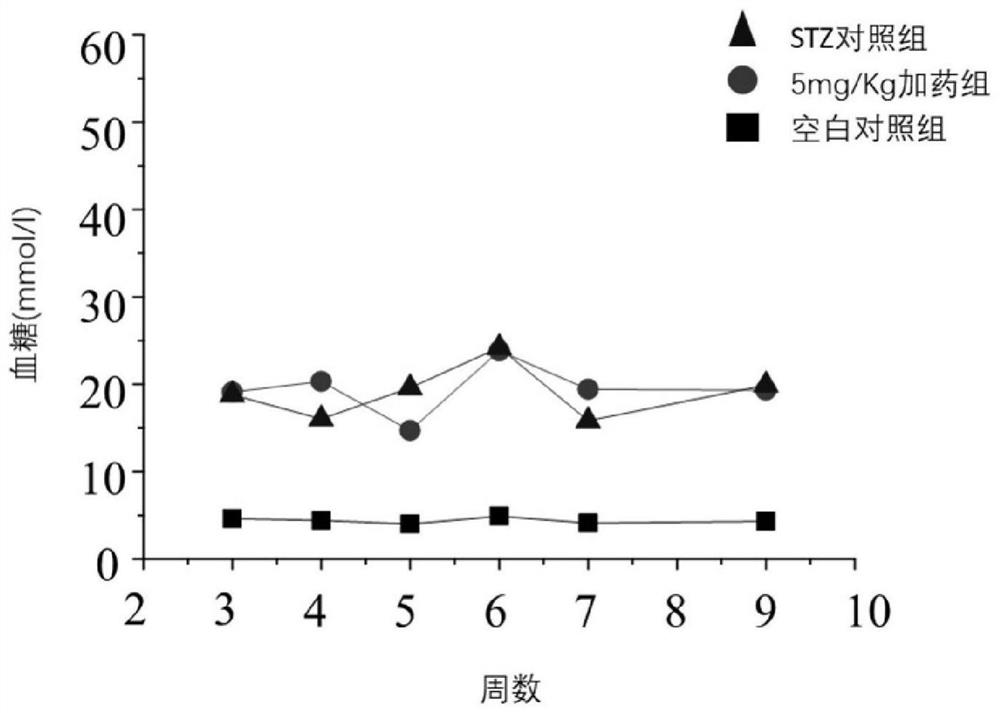Application of potassium ATP channel regulator in preparation of medicine for resisting diabetic nephropathy
A technology for diabetic nephropathy and anti-diabetes, which is applied in the field of chemical medicine of potassium ATP channel regulators, can solve problems such as unknowing, and achieve the effect of reducing urinary microalbumin
- Summary
- Abstract
- Description
- Claims
- Application Information
AI Technical Summary
Problems solved by technology
Method used
Image
Examples
Embodiment 1
[0079] Example 1 Establishment of Diabetic Nephropathy Model and Drug Detection Method
[0080] 1. Establishment of diabetes model
[0081] Streptozotocin at low doses induces apoptosis and at high doses causes necrosis in a murine pancreatic β cell line, INS1[J]. International Union of Biochemistry and Molecular Biology Life.1996,39(6):1229-1236.), the pathophysiological characteristics of the rats modeled by STZ are relatively close to those of humans, and blood sampling can be repeated to monitor index changes, and sufficient Kidney tissue for subsequent histological section analysis. Therefore, STZ was chosen to create a diabetic rat model. In addition, due to the high toxicity of STZ, the model can be better established by multiple injections at low doses. After modeling, a high-fat diet was administered every day until the end of the experiment. High-fat diet can induce diabetic nephropathy in STZ rats.
[0082] See Embodiment 2 for the specific modeling method.
...
Embodiment 2
[0109] Embodiment 2 studies the impact of diazoxide on diabetic nephropathy
[0110] 【Purpose】
[0111] On the basis of the rat model of diabetic nephropathy constructed in Example 1 and the detection method, this example aims to investigate whether high, medium and low doses of diazoxide have a therapeutic effect on diabetic nephropathy.
[0112] 【experimental method】
[0113] After 7 days of adaptive feeding of SD rats, 10 SD rats were randomly selected as a blank control group (Group A), that is, no injection of STZ. The remaining 65 rats were randomly divided into 4 groups, 14 of which were the negative control group, and 17 rats in each group. After feeding high-fat diet for 2 weeks to induce insulin resistance, the diabetes model was established. The specific modeling method is as follows:
[0114](1) After fasting for at least 12 hours, inject STZ at a dose of 30 mg / kg, and eat and drink freely after injection;
[0115] (2) Measure the fasting blood glucose 48 hours ...
Embodiment 3
[0145] Embodiment 3 studies the remaining K ATP Effect of agonists on diabetic nephropathy
[0146] 【Purpose】
[0147] On the basis of the diabetic nephropathy rat model and detection method constructed in Example 1, this example aims to investigate the remaining K ATP Whether agonists have a therapeutic effect on diabetic nephropathy.
[0148] 【experimental method】
[0149] After 130 SD rats were adaptively fed for 7 days, 10 were randomly selected as the blank control group, that is, no injection of STZ. The remaining 120 rats were randomly divided into 8 groups (comprising: negative control group, 1mg / Kg krocarin group, 1mg / Kg pinacidil group, 0.5mg / Kg nicodinil group, 1mg / Kg apuka Lin group, 1mg / Kg quinetazolone group, 0.5mg / Kg minoxidil group, 5mg / Kg nigudipine group), 15 rats in each group, after feeding with high-fat diet for 2 weeks to induce insulin resistance, start to establish Diabetes model, the specific modeling method and detection method are the same as in...
PUM
 Login to View More
Login to View More Abstract
Description
Claims
Application Information
 Login to View More
Login to View More - R&D
- Intellectual Property
- Life Sciences
- Materials
- Tech Scout
- Unparalleled Data Quality
- Higher Quality Content
- 60% Fewer Hallucinations
Browse by: Latest US Patents, China's latest patents, Technical Efficacy Thesaurus, Application Domain, Technology Topic, Popular Technical Reports.
© 2025 PatSnap. All rights reserved.Legal|Privacy policy|Modern Slavery Act Transparency Statement|Sitemap|About US| Contact US: help@patsnap.com



